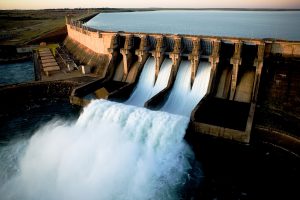Kinetic energy of water in rivers is created by the transformation of potential energy into water flows. Both forms of energy (potential and kinetic energy) can be converted into electricity in hydro power stations. Efficiencies range up to 97 percent.

Hydro power
When sunlight intercepts with the surface of water bodies or moist earth, the energy of the incident sunlight causes the water to evaporate. The major part of water is evaporated from the oceans, covering a large part of the earth’s surface. While the warm and humid air rises, it cools down in the atmosphere causing the formation of clouds. Finally the hydrological cycle reaches its last stage, when water in form or precipitations reaches the oceans and land areas. Due to gravity the precipitation onto land surfaces flows back into the oceans via streams and rivers.
The energy in the water is used to drive turbines. Depending on the drop height, thus the potential energy, and the volume of water Crossflow, Francis, Kaplan or Pelton turbines are used. Those turbines are very robust and withstand heavy loads, pollution, flooding and frost. The technical operation time is generally more than 50 years.
Hydro power plants can be differentiated according to run-of-river, storage and pumped-storage power plants. In any case of those hydro power plants a certain minimum height of fall is required. That means inflow and outflow occur at different levels of elevation.



